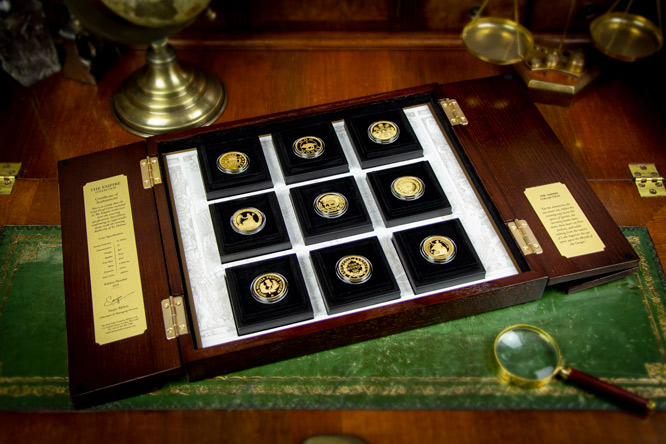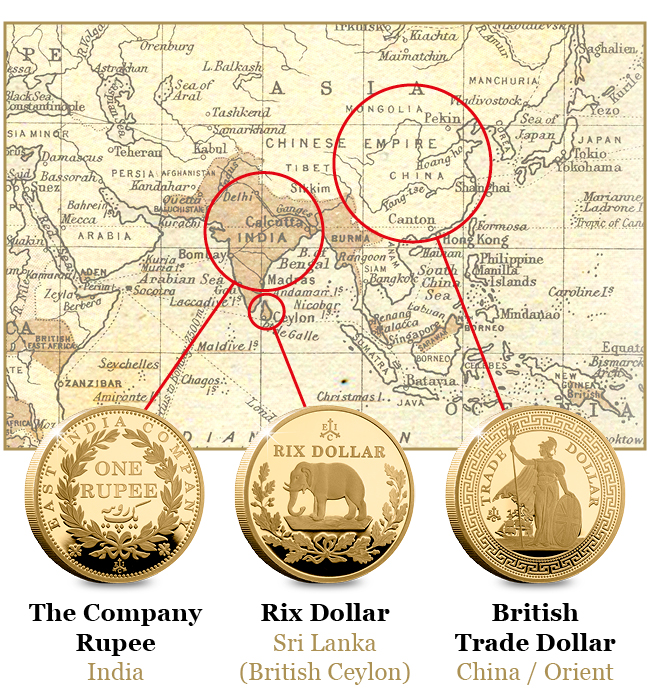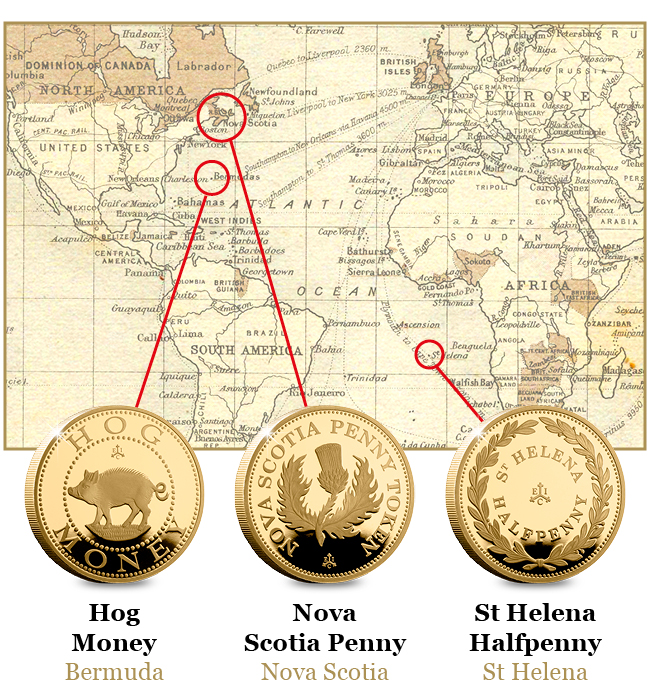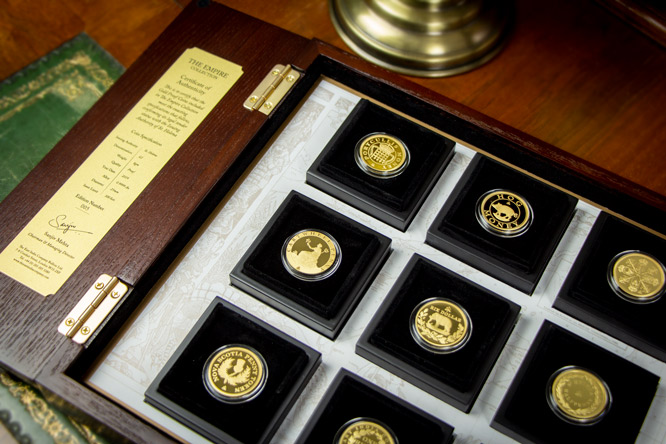Posts Tagged ‘benedetto pistrucci’
Discover the coins that built the British Empire
The East India Company is living proof of Sir Walter Raleigh’s (1614) prophetic words: “whosoever commands the sea, commands the trade, whosoever commands the trade of the world commands the riches of the world and consequently the world itself,” as they rapidly became a trading force to be reckoned with.
And coins were one of the key ways the company managed trade across the globe.

At its peak the EIC was single-handedly responsible for half the world’s trade, including cotton, silk, spices, opium and tea.
Remarkably, the East India Company is still trading today. And they have just authorised a set of limited edition Gold coins paying tribute to the most important coins in their history.
Here is the story behind the coins…

Portcullis Money – 1601 (Throughout the Empire)
Ordered by Queen Elizabeth I to facilitate increased commerce on behalf of the British Crown and to compete against the widely used Spanish Real. These were the first coins issued for the British Empire outside of England’s normal coinage.
The Cartwheel Penny – 1797 (Australia)
The Cartwheel Penny was the first British coin to be exported to Australian Colonies. It was introduced to help curb Britain’s chronic coin shortage which was impacting economic growth. Specially designed to prevent counterfeiting, and the thick rim and inscription led to the pennies being informally named ‘The Cartwheel Penny’.
The Elephant and Castle Guinea – 1663 (Throughout the Empire)
The guinea is regarded as the most successful trade coin, exponentially increasing British and local trade wherever it was introduced. This Guinea was the first British machine-struck coin, and adopted its name from where the gold was mined from.

The Company Rupee – 1833 (India)
The Rupee is one of the world’s oldest systems of money. It was adopted by the East India Company upon its arrival in the East, and soon became one of the company’s most important coins and means for trade. In 1833 reforms to the Indian weights and measures led to coinage in India changing from the Sicca to the standard ‘Company Rupee’.
The Rix Dollar – 1821 (Sri Lanka)
Great Britain sought to develop Ceylon’s (Sri Lanka’s) economy and increase trade to and from Europe. As a part of this aim The Rix Dollar was struck specifically for use in Ceylon. Designed by Benedetto Pistrucci, who is also responsible for the now iconic rendition of St. George slaying the Dragon which features on British Sovereigns.
The British Trade Dollar – 1839 (The Orient)
To facilitate the trade of their most lucrative commodities, namely tea and opium a trading post in Canton, China was established. During the Trade Wars Great Britain found itself having to rely more and more on its own silver coinage, and this paved the way for one of the most distinctive silver British coins in numismatic history to be struck: the British Trade Dollar.

Hog Money – 1609 (Bermuda)
In order to develop Bermuda’s prosperous economy King James I granted permission to mint coins, which resulted in the issuing of Hog Money, inspired by the wild hogs previously introduced to the island, it’s the first English coin to be minted specifically for use in North America.
The St Helena Halfpenny – 1821 (St Helena)
In 1815 St Helena’s economy benefited from the arrival of the former French Emperor, Napoleon, during his second exile, as the famous prisoner brought with him an entourage of British troops, effectively doubling the islands population and prosperity. As the economy swelled, St Helena’s first local coins were introduced.
The Nova Scotia Penny – 1823 (Canada)
Prior to the Canadian Confederation in 1867 many provinces issued their own coinage. However in 1823, without seeking official approval from the Home Office, the province of Nova Scotia ordered the issuing of coins. The coins, issued in denominations of one pennies and halfpennies, contributed to the expansion of local commerce in Nova Scotia.

The 2019 Empire Collection
For this exceptional 2019 issue collectors will be taken on a journey to the far flung corners of the world. Retracing the steps of the East India Company, to discover some of the most significant coins which have helped build an empire stretching across three centuries from 1600 to the Victorian Era.
Finished to an exceptionally high standard, the 2019 collection truly represents the global resonance of The East India Company and these significant coins. There is no doubt the 2019 Empire Collection is going to become a future collector priority.
If you are interested…
Out of a Worldwide edition limit of just 100 we have a small stock of the 2019 Empire Collection available. If you are interested in owning a set – please complete the form below and we will contact you directly.
[contact-form to=”Dave.Potter@westminstercollection.com” subject=”I’m interested in the 2019 Empire Collection – Sign ups from Westminster Blog”][contact-field label=”Name” type=”name” required=”1″][contact-field label=”Postcode” type=”text” required=”1″][contact-field label=”Email” type=”email” required=”1″][contact-field label=”Phone Number” type=”text” required=”1″][/contact-form]
200 years of the Sovereign. Part VI: The UK’s Premier Gold Coin
2017 sees the Gold Sovereign’s bicentenary, and to mark the occasion a special one-year-only design has been unveiled, recreating Pistrucci’s original 1817 engraving. It’s a truly fitting tribute and acknowledges the rich history of the coin which I’ve been exploring in these blogs. If you missed the previous posts you can start from the beginning here, but now here’s the final chapter in the sovereign’s history so far…
In Part V, I explored the decline in production of Gold Sovereigns as a result of World War I and the worldwide economic crisis, which lead to the end of the Sovereign. Until 1957 when it was revived once again…
Apart from one special limited edition commemorative issue for King George VI’s coronation in 1937, no Sovereigns had been struck since 1932. In 1953, Sovereigns were produced for Queen Elizabeth II for the Coronation Sets but they were for national collections, not collectors.
The Sovereign’s revival
Then in 1957, worldwide demand for the coins became so great that The Royal Mint resumed production of bullion gold Sovereigns for circulation. Not only would this satisfy demand, it would also blunt the premium that was making it so lucrative to counterfeit the coins.
These early ‘restoration’ Sovereigns of Queen Elizabeth II’s reign feature Mary Gillick’s portrait of the young Queen on the obverse, engraved especially for her new coinage.
The portrait design was changed in 1968 prior to Decimalisation in 1971, to a portrait by Arnold Machin. This portrait still features on postage stamps all these years later.
A new market emerges
Queen Elizabeth II’s reign has been a time of change for the Sovereign. A new market has emerged – the collector’s market.
In 1979, The Royal Mint produced the first proof version of the Sovereign of her reign. This higher grade version was limited to just 12,500 pieces and proved very popular with collectors.
With a newfound interest from collectors, it is not surprising that we have seen more design variations of the Sovereign than ever before.
A third portrait design by Raphael Maklouf was used from 1985 to 1997 and a fourth by Ian Rank-Broadley FRBS replaced this until 2015 when Her Majesty’s portrait was updated by The Royal Mint engraver, Jody Clark.
The UK’s Premier Gold Coin
We have also seen the introduction of commemorative one-year-only designs, which started in 1989 with the issue of a special 500th anniversary Sovereign, featuring a design similar to the first Sovereign in 1489. These special commemorative designs have become more and more popular.
Since then, there have been one-year-only designs for the Queen’s Golden Jubilee in 2002, the modern St. George and the Dragon in 2005, the Diamond Jubilee in 2012 and the Queen’s 90th birthday in 2016.
These limited editions have seen a surge in Sovereign collecting, cementing its position as the UK’s premier gold coin.
It’s universal appeal shows no sign of slowing. In recent financial crises, people all over the world clamoured for Gold Sovereigns.
The Sovereign’s reputation for quality and reliability remains and will remain for years to come and now the next chapter in the Sovereign story has been written…
Announcing the new UK Bicentenary Gold Proof Sovereign
To mark the Bicentenary of the “modern” Gold Sovereign in 2017, The Royal Mint have just released a brand new Gold Proof Sovereign reprising Benedetto Pistrucci’s original engraving from 1817.
With a low edition limit of just 10,500 worldwide, a special one-year-only design change and a fine proof finish, the 2017 Bicentenary Gold Sovereign has all the elements to be one of the most collectable British gold coins of the 21st century. And now you can own one.
200 years of the Sovereign. Part V: The End of the Sovereign…
In my last blog post, I explored the Gold Sovereign’s incredible success as the most trusted and popular of all gold circulating coins throughout the world during the Empire years until 1931 when its reign as the King of Coins came under threat…
The Outbreak of the First World War in 1914, followed by the worldwide economic crisis in 1931 seemed to sound the death-knell for the Sovereign.
Gold Sovereigns were struck annually until 1915, but production dropped dramatically in 1914 and the majority of the 20 million minted in 1915 were for overseas use.
Decline in Production
As part of the emergency measures put in place upon the Outbreak of the First World War, specie payments were suspended and Treasury notes replaced gold. Gold coins disappeared from circulation but they continued to be minted for overseas bullion transactions.
Sovereigns were struck in 1916 and a small amount in 1917, but no more circulating Sovereigns were minted in London, except for a consignment for overseas use in 1925. The overseas branch mints still struck considerable quantities of Sovereigns.
Sovereign production continued after the war, but in much smaller numbers. Despite this, another two branch mints were opened. One in Bombay in 1918, which struck Sovereigns for just one year only. The other was opened in South Africa in 1923.
By 1926, only three branch mints were still operating – Perth, Melbourne and Pretoria. However, the worldwide economic crisis in 1931 signalled the end of these remaining branch mints, Britain left the Gold standard and the last Sovereigns were struck in Pretoria in 1932.
This appeared to be the end of the Sovereign. But all was not as it seemed.
Would the Sovereign be revived again?
Find out in the final part of our 200 years of the Sovereign Blog Series – click here to read it >>
Announcing the new UK Bicentenary Gold Proof Sovereign
To mark the Bicentenary of the “modern” Gold Sovereign in 2017, The Royal Mint have just released a brand new Gold Proof Sovereignreprising Benedetto Pistrucci’s original engraving from 1817.
With a low edition limit of just 10,500 worldwide, a special one-year-only design change and a fine proof finish, the 2017 Bicentenary Gold Sovereign has all the elements to be one of the most collectable British gold coins of the 21st century. And now you can own one.






